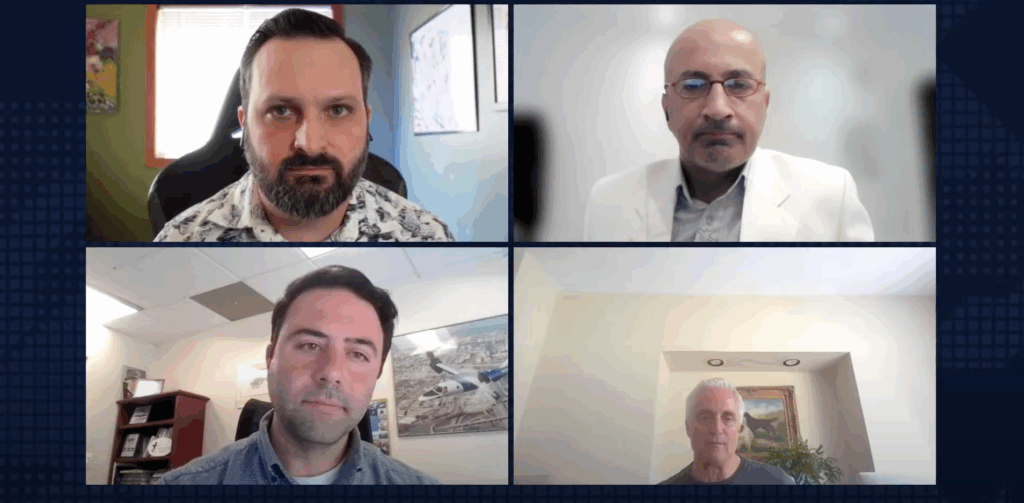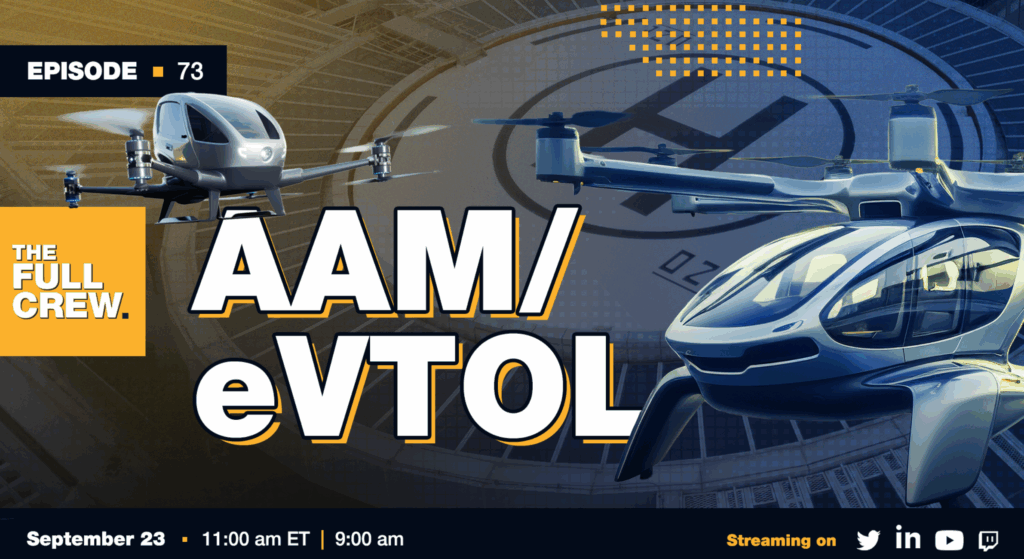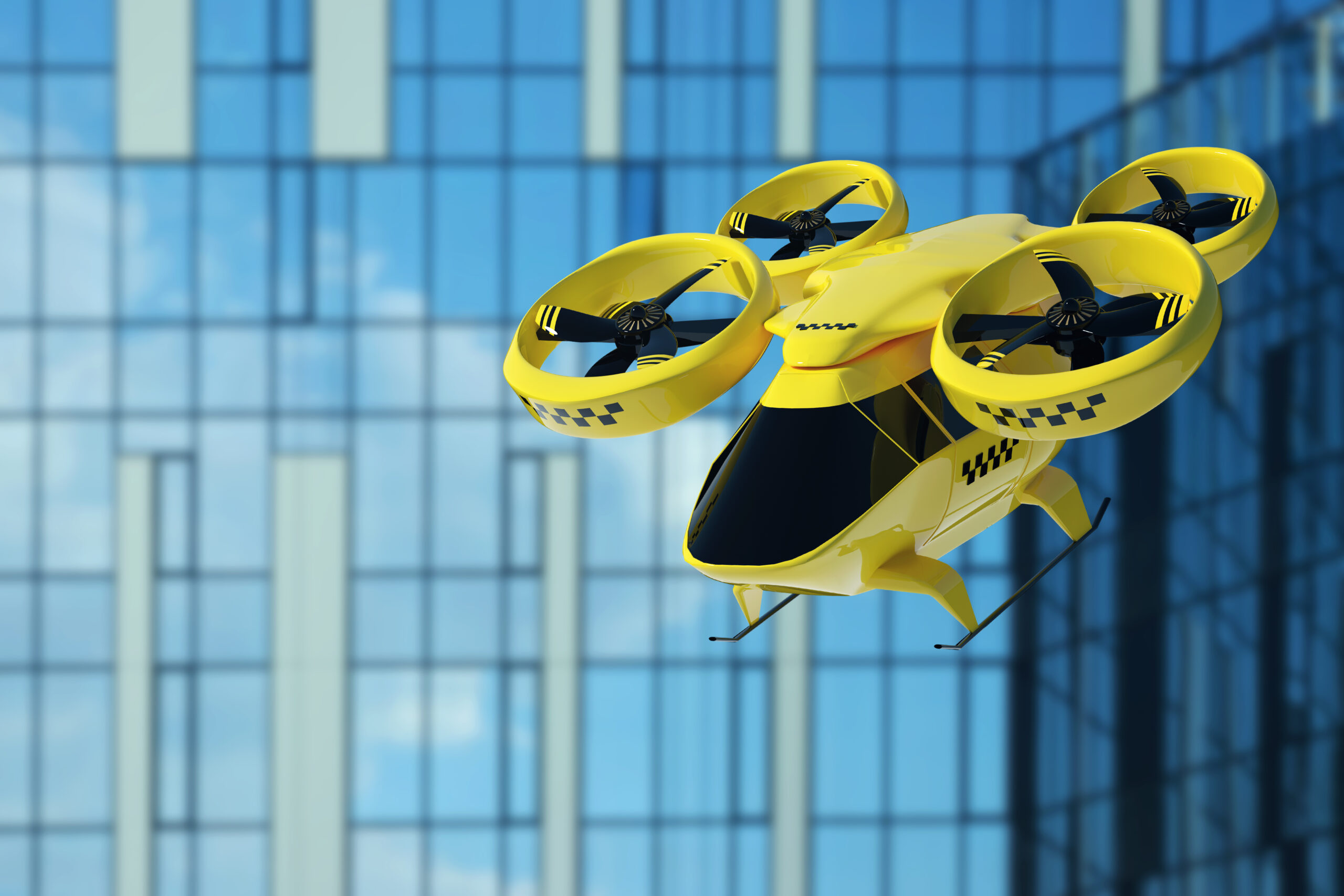By: Dawn Zoldi
2025 has marked a pivotal year for Advanced Air Mobility (AAM) and electric vertical takeoff and landing (eVTOL) across the world. With new partnerships, ground-breaking events, and ambitious pilot programs, these aircraft continue to reshape how cities approach transportation, urban planning and sustainability. In the latest Full Crew newscast, host Mike Pehel moderated an expert panel featuring TruWeather Solutions’ CEO Don Berchoff, Advanced Air Mobility Institute’s Capt Fahad Masood, and the Vertical Flight Society’s Executive Director Angelo Collins. This Crew rediscussed the hottest topics, and hardest questions, facing the AAM industry, as it continues to move from theory into practice.

Hybrid Power and Defense Partnerships: Beta-GE’s Takeoff
The evolution from pure-electric propulsion to hybrid systems, especially for defense and heavy-duty applications, seemed to be one of the foundational trends in 2025. Recent headlines highlighted Beta Technologies’ partnership with GE Aerospace to design hybrid eVTOLs that push the boundaries of range, payload and mission flexibility.
According to Collins, these collaborations blend the commercial sector’s electric innovation with the defense sector’s legacy in power and reliability. They open new markets and operational scenarios. Masood agreed that these and other “mergers…acquisitions and collaborations will facilitate the growth of the AAM space.”
But why deviate from a purely electric model? Berchoff, who brings decades of military, meteorology and logistics expertise, pointed out the “nightmare” reality of “trying to figure out how…to get electric capabilities (think: chargers) …downrange to support electric vehicles” fueled (no pun) some of these hybrid approaches. Having overcome some of these hurdles, the AAM industry still has to address significant others, such as weather (of course, this one was from the “Weather Don”), endurance and energy density.
Nevertheless, in Masood’s words, it may be “just a matter of time” for industry maturity. And the Beta-GE alliance to deploy long-range, hybrid aircraft with strategic civil and military utility provides us all with some proof of the AAM sector’s dynamic momentum.
Dubai Air Show 2025: Global Hub for Vertical Mobility
On the international stage, the Dubai Air Show, as a brand, has in the past and will in the 2025 show emerge as a critical venue for demonstrating AAM technologies, regulatory strategies and real-world integration. The event will feature an AAM pavilion, multinational exhibitors and infrastructure innovation unveilings of “skyports,” dedicated urban landing hubs.
Dubai has uniquely positioned itself as an AAM leader, as it has done in other technology development fields. It fosters this by gathering leaders, engineers and regulators in one place to accelerate adoption and cross-border collaboration. As Berchoff also noted, the region’s extreme environmental conditions provide a vital testbed for both battery management and weather resilience of eVTOLs.
“Advanced air mobility is certainly a launch pad for the future because it connects so many different variables from the ecosystem,” Masood explained. Quoting Steve Jobs, he continued, “‘Innovation distinguishes between a leader and a follower,’ and that innovation is what is happening in AAM space right now in the United Arab Emirates (UAE).’”
Collins underscored the visibility that Dubai provided AAM to the global audience. “Air shows serve a purpose: to generate orders or just interest. We’re still having trouble getting the word out about these aircraft.” But the Dubai Air Show provided a grand stage for eVTOLs. It also emphasized the UAE’s role as a crossroads for commercial deals, regulatory dialogue and global branding of next-gen aviation.

FAA’s eVTOL Integration Pilot Program: Regulation Meets Innovation
No discussion of AAM in 2025 would be complete without addressing how regulators and industry continue to balance innovation and public safety. The panel highlighted the FAA’s eVTOL AAM Integration Pilot Program (eIPP) as a signature initiative where selected U.S. projects will demonstrate operational, technical and business model viability over the next three years. (See prior AG coverage of the eIPP).
Berchoff explained that the program will demand robust partnerships across aerospace, technology and operations. In his opinion, it will require state and private investment, public buy-in and scalable, business-driven solutions rather than solely federal government appropriations. “The eIPP is an outgrowth of the drone IPP back in 2017-18,” he said. “The FAA is not going to guarantee any money…good state support [or grants] will probably have an advantage,” and physical infrastructure, such as weather technology and systems, will require a public/private partnership investment model. Berchoff believes weather infrastructure will, in the end, generate more revenue than costs for operators.
Collins applauded the effort as a way to help jump-start industry and challenge the status quo. He pointed to lengthy certification cycles, compared to swift demonstrations in China and the UAE, as crying out for American acceleration. “We need a win. Even if it’s a lowercase ‘W’ win, we need something. The FAA and this administration are willing to help accelerate things,” he noted.
Masood highlighted the global parallels between Dubai and the eIPP. “Where UAE is building the playground, the FAA is writing the rule book,” he articulated.
Regulatory agility and infrastructure scaling must go hand-in-hand if the U.S. wants to remain in the technological vanguard. The program’s focus on air taxis, regional flights, automation and safety points to the desire of rapidly expanding the definition, and actual operationalization, of AAM. Through the eIPP, the FAA has illustrated, yet again, that safety and business viability are inseparable in aviation. This holds especially true for AAM, as it continues to mature.
Evolving Workforce, Community Acceptance and Regulatory Agility
Beyond the hardware and headlines, the Full Crew’s experts illuminated the human and societal forces that will shape AAM’s trajectory.
Collins advocated for education and workforce development. Training and recruitment must keep pace with growing demand for new aviation skillsets. “There’s only so many helicopter engineers that exist…I would certainly strongly motivate you to study eVTOL, AAM right now,” he urged the virtual audience.
From the industry perspective, Berchoff noted that mutual understanding between businesses and regulators remains essential for sustainable progress. “The regulator is more flexible now than I’ve ever seen…,” he said. “They know safety is the priority, but are willing to support the business case.”
As always, community engagement and public acceptance also rise to the top of the list of “must haves” for AAM to succeed. “Let’s not forget about community acceptance, engagement…AAM is a complex blend of events and capabilities,” Berchoff noted, that requires the industry to gain trust and buy-in from local stakeholders.
Future Flightpath for Urban Air Mobility
2025 appears to be a year of inflection for AAM and eVTOLs, where technical ambition has been balanced with regulatory realism, industry optimism and pragmatic partnerships. Global showcases like the Dubai Air Show reveal how international alliances accelerate innovation and scale. U.S. pilot programs and regulatory innovation remain critical to foster trust, safety and business viability. In the end, today’s hybrid propulsion breakthroughs, infrastructure investments, regulatory pilot programs and educational campaigns will carve the path for tomorrow’s air taxis and regional eVTOL flights. The future of AAM is not just about aircraft. It’s about people, policies, partnerships and, of course, the persistent drive to turn ambitious dreams into daily realities.
Read the articles referenced by the AAM/eVTOL Full Crewcast:
- “GE Aerospace and BETA Technologies partner to advance hybrid electric flight,” GE Press Release, Sep 4, 2025
- “Dubai Airshow 2025 will set new pace for Advanced Air Mobility,” Gulf Today, Aug 28, 2025
- “Trump’s Transportation Secretary Sean P. Duffy Unveils New Plan to Fast-Track Advanced Air Mobility Vehicles,” FAA website, Sep 12, 2025

